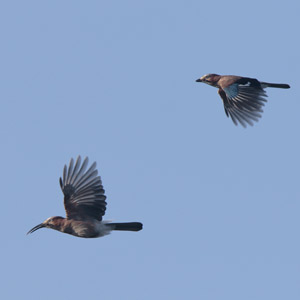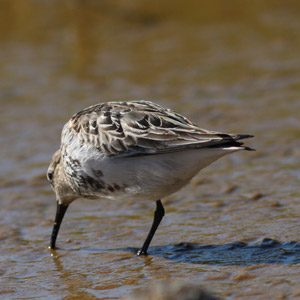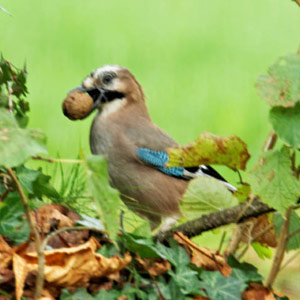Pratique | Débuter
Un Geai des chênes avec un bec étonnant observé en Bretagne

Geai des chênes (Garrulus glandarius) au bec allongé et recourbé volant avec un congénère au bec normal, Ille-et-Vilaine (France), mars 2019.
Photographie : Patrick Menard
Introduction
Les oiseaux au bec anormal sont rares dans la nature (moins de 1 %), certainement à cause du faible taux de survie des individus touchés, qui éprouvent des difficultés à se nourrir et à se débarrasser de leurs parasites. La littérature regorge de cas (parfois spectaculaires) d’oiseaux sauvages appartenant à des familles variées présentant une malformation. Il existe différentes anomalies, principalement des allongements, des croisements et des déviations des mandibules. Elles résultent d’une perturbation de la croissance de la couche de kératine qui recouvre le bec (la ramphothèque), mais les causes ne sont pas encore bien connues.
En mars 2019, Patrick Menard a observé et photographié en Ille-et-Vilaine (France) un Geai des chênes (Garrulus glandarius) avec un étonnant bec allongé et recourbé volant avec un congénère.
Après une présentation des différentes malformations des becs, nous évoquons leurs causes possibles et leur impact sur la survie des oiseaux touchés.
Abstract
Birds with an abnormal beak are rare in nature (less than 1%), certainly because of the low survival rate of affected individuals, which have great difficulty in feeding themselves and eliminating their parasites. The literature is full of cases (sometimes spectacular) of wild birds belonging to various families with a beak malformation. There are types of deformities, mainly elongations, crosses and deviations of the mandibles. They result from a disruption of the growth of the keratin layer that covers the beak (the ramphotheca), but the causes are not yet well understood.
In March 2019, Patrick Menard watched and photographed an Eurasian jay (Garrulus glandarius) with an a lengthened and curved beak flying with a normal congener in Ille-et-Vilaine (France). After a presentation of the beak malformations, we enumerate their possible causes and their impact on the survival of the affected birds.
Poursuivez la lecture de cet article, en vous abonnant dès maintenant !
Découvrez les Archives d’Ornithomedia.com
Pour seulement 10,00 €TTC/an (ou 6,00 € les 6 mois)
Profitez de plusieurs centaines d’articles en accès illimité et sans aucun engagement.
Compléments
Sources
- Maxine Zylberberg, Caroline Van Hemert, Colleen M. Handel et Joseph L. DeRisi (2018). Avian keratin disorder of Alaska black-capped chickadees is associated with Poecivirus infection. Virology Journal. Numéro : 15. Page : 100. https://virologyj.biomedcentral.com
- Caroline Van Hemert et Colleen M. Handel (2016) Elements in Whole Blood of Northwestern Crows (Corvus caurinus) in Alaska, USA: No Evidence for an Association with Beak Deformities. Journal of Wildlife Diseases. Volume : 52. Numéro : 3. Pages : 713-718. Juillet. www.jwildlifedis.org
- Colleen M. Handel, Caroline van Hemert (2015). Environmental contaminants and chromosomal damage associated with beak deformities in a resident North American passerine. Environmental Toxicology. Date : 06/01. www.academia.edu
- Caroline Van Hemert et Colleen M. Handel (2010). Beak Deformities in Northwestern Crows: Evidence of a Multispecies Epizootic. The Auk: Ornithological Advances. Volume : 127. Numéro : 4. Pages : 746–751. https://academic.oup.com
- Colleen M. Handel Lisa M. Pajot Steven M. Matsuoka, Caroline Van Hemert, John Terenzi, Sandra L. Talbot, Daniel M. Mulcahy, Carol U. Meteyer et Kimberly A. Trust (2010). Epizootic of Beak Deformities Among Wild Birds in Alaska: An Emerging Disease in North America? The Auk: Ornithological Advances. Volume : 127. Numéro : 4. Pages : 882–898. Octobre. https://academic.oup.com
- Raju Kasambe, Aditya Joshi et Sathyan Meppayur (2009). Bill deformities in House Crows Corvus splendens, Large-billed Crow C. macrorhynchos and Yellow-billed Blue Magpie Urocissa flavirostris in India. Newsletter for Birdwatchers. Volume : 49. Numéro : 5. https://upload.wikimedia.org
- D. E. Pomeroy (1962). Birds with abnormal bills. British Birds. Volume : 55. Numéro : 2. britishbirds.co.uk







Aucun commentaire sur ce sujet
Participer à la discussion !